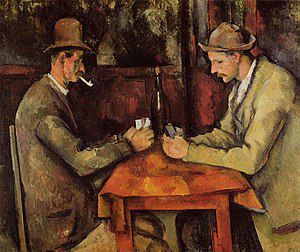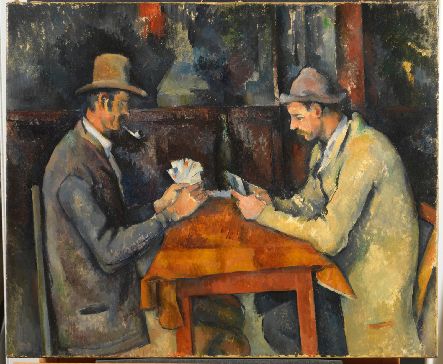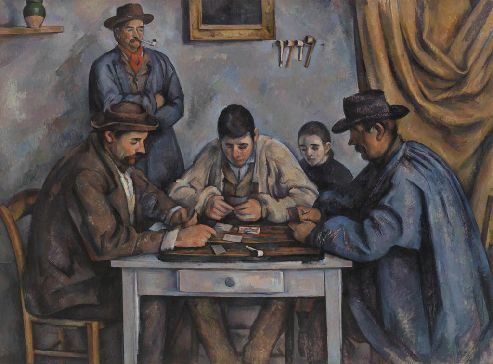Cezanne, Cards & Canasta
I have to confess that I not only paint a bit but I like to play the Spanish card game Canasta and I’m getting ready for my monthly Card Evening so don’t have time to write a proper blog today! However in the light of this revelation I will share some wonderful paintings of card players by the French Post-Impressionist painter Paul Cezanne.

The Card Players series of oil paintings was produced during Cézanne's final period in the early 1890s and there are five paintings in the series. The versions vary in size, the number of players, and the setting in which the game takes place. Cézanne also completed numerous drawings and studies in preparation for The Card Players series. (Wikipedia)


And yet another. But this painting is special because in 2011 (though not revealed until 2012) the tiny oil-rich nation of Qatar purchased a Paul Cézanne painting, The Card Players, for more than $250 million. The deal, in a single stroke, sets the highest price ever paid for a work of art and upends the modern art market. (vanityfair.com)

If the price seems insane, it may well be, since it more than doubles the current auction record for a work of art. And this is no epic van Gogh landscape or Vermeer portrait, but an angular, moody representation of two Aix-en-Provence peasants in a card game. But, for its $250 million, Qatar gets more than a post-Impressionist masterpiece; it wins entry into an exclusive club (owners of Cezanne's card players). For a nation in the midst of building a museum empire, it’s instant cred.
Is the painting, created at the cusp of the 20th century, worth it? Well, Cézanne inspired Cubism and presaged abstract art, and Picasso called him “the father of us all.” That said, “$250 million is a fortune,” notes Victor Wiener, the fine-art appraiser called in by Lloyd’s of London when Steve Wynn put his elbow through a Picasso, in 2006. “But you take any art-history course, and a Card Players is likely in it. It’s a major, major image.” For months, he said, “its sale has been rumored. Now, everyone will use this price as a point of departure: it changes the whole art-market structure.”
The Cézanne sale actually took place in 2011, and details of the secret deal are now coming out as a slew of V.I.P. collectors, curators, and dealers head to Qatar for the opening next week of a Takashi Murakami blockbuster that was recently on view in the Palace of Versailles. The nation, located on its own small jetty off the Arabian Peninsula, is a new destination on the art-world grand tour: current exhibitions include an 80-foot-high Richard Serra and a Louise Bourgeois retrospective (her bronze spider is crawling across the Doha Convention Center), and in March it hosts a Global Art Forum that attracts artists, curators, and patrons from museum groups worldwide. (vanityfair.com)

Paul Cézanne’s famous paintings of peasant card players have long been considered to be among his most iconic and powerful works.
Each painting in Cezanne's series shows two or more Provencal peasants quietly smoking their pipes and playing cards. They were mostly modelled on workers from the Cezanne family estate known as Le Jas de Bouffan, many of whom came to sit for him over the years, including an old gardener known as 'le pere Alexandre' and a farm worker by the name of Paulin Paulet - both of whom appear in the two card-player versions of the subject.
At any rate, unlike the drunken, rowdy peasants memorialized in the seventeenth century paintings of the Dutch Realist School of genre painting (1600-1700), Cezanne's peasants are all studiously intent on the card game in front of them, and make no attempt at conversation. There is no excitement or melodrama. On the contrary, Cezanne's figure painting conveys a sense of timeless tranquility throughout the series. In his book "Cezanne. A Study of His Development" (1927), the art critic Roger Fry (1866-1934), a leading authority on Post-Impressionism, described Cezanne's card players as having such an extraordinary sense of monumental gravity that they have found their true centre and can never be moved. (visual-arts-cork.com)
PS
My card playing group bear very little resemblance to Cezanne's. To start with we are all women - we won't let the husbands play! Did peasant women play cards? But the greatest difference is that Cezanne's players are extremely serious about the game - most likely there was a small pile of money at stake. We take a much lighter approach to the task at hand. We don't smoke I'm pleased to say but we do eat and drink a little!!
Tomorrow back to facial features as seen on clowns which are closely related to card players!!
